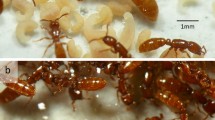Abstract
A colony of Protanilla sp. was collected from the floor of a selectively logged forest in Ulu Gombak, Peninsular Malaysia, in March 2011. The colony contained 17 ergatoid queens and 25 workers. The ergatoid queens had 6–10 ovarioles per individual with a sperm-filled spermatheca while workers had two ovarioles and a vestigial spermatheca. In the laboratory, foraging workers responded to Occasjapyx sp. (Japygidae) only; larvae, workers, and ergatoid queens fed on this prey. Ergatoid queens frequently showed larval and egg care, and transported larvae when the nest was disturbed. Compared to Leptanilla, morphological and behavioral specialization of both castes in Protanilla sp. does not seem developed.







Similar content being viewed by others
Availability of data and materials
Not applicable.
Code availability
Not applicable.
References
Barandica JM, López F, Martínez MD, Ortuño VM (1994) The larvae of Leptanilla charonea and Leptanilla zaballosi (Hymenoptera, Formicidae). Dtsch entomol Z 41:147–153
Baroni Urbani C, De Andrade ML (2006) A new Protanilla Taylor, 1990 from Sri Lanka. Myrmecol News 8:45–47
Billen J, Bauweleers E, Hashim R, Ito F (2013) Survey of the exocrine system in Protanilla wallacei (Hymenoptera, Formicidae). Arthropod Struct Dev 42:173–183
Borowiec ML, Rabeling C, Brady SG, Fisher BL, Schultz TR, Ward PS (2019) Compositional heterogeneity and outgroup choice influence the internal phylogeny of the ants. Mol Phylogenet Evol 134:111–121
Brady SG, Schultz TR, Fisher BL, Ward PS (2006) Evaluating alternative hypotheses for the early evolution and diversification of ants. Proc Natl Acad Sci USA 103:18172–18177
Emery C (1870) Studi mirmecologici. Bull Soc Entomol Ital 2:193–201
Hölldobler B, Wilson EO (1990) The ants. Belknap Press of Harvard University, Cambridge
Hsu PW, Hsu FC, Hsiao Y, Lin CC (2017) Taxonomic notes on the genus Protanilla (Hymenoptera: Formicidae: Leptanillinae) from Taiwan. Zootaxa 4268:117–130
Ito F, Yamane SK (2020) Behavior of a queen of Leptanilla clypeata Yamane et Ito collected in the Bogor Botanical Gardens, West Java, Indonesia (Hymenoptera; Formicidae), with a note of colony composition and a description of the ergatoid queen. Asian Myrmecol 12:e012004
Katayama M, Tsuji K (2011) Notes on prey menu of Protanilla lini in Okinawa Island. Ari 31:17–20 ((in Japanese))
Kück P, Hita Garcia F, Misof B, Meusemann K (2011) Improved phylogenetic analyses corroborate a plausible position of Martialis heureka in the ant tree of life. PLoS ONE 6:e21031
Kutter H (1948) Beitrag zur Kenntnis der Leptanillinae (Hym. Formicidae). Eine neue Ameisengattung aus Sud-Indien Mitt Schweiz Entomol Ges 21:286–295
Man P, Ran H, Chen Z, Xu Z (2017) The northern-most record of Leptanillinae in China with description of Protanilla beijingensis sp. nov. Asian Myrmecol 9:e009008. https://doi.org/10.20362/am.009008
Masuko K (1989) Larval hemolymph feeding in the ant Leptanilla japonica by use of a specialized duct organ, the “larval hemolymph tap” (Hymenoptera: Formicidae). Behav Ecol Sociobiol 24:127–132
Masuko K (1990) Behavior and ecology of the enigmatic ant Leptanilla japonica Baroni Urbani (Hymenoptera: Formicidae: Leptanillinae). Insectes Soc 37:31–57
Molet M, Peeters C, Follin I, Fisher BL (2007) Reproductive caste performs intranidal tasks instead of workers in the ant Mystrium oberthueri. Ethology 113:721–729
Ogata K, Terayama M, Masuko K (1995) The ant genus Leptanilla: discovery of the worker-associated male of L. japonica, and a description of a new species from Taiwan (Hymenoptera: Formicidae: Leptanillinae). Syst Entomol 20:27–34
Terayama M (2013) Additions to knowledge of the ant fauna of Japan (Hymenoptera; Formicidae). Memoir Myrmecol Soc Jpn 3:1–24
Terayama M, Kinomura K (2015) Rediscovery of Leptanilla kubotai Baroni Urbani (Hymenoptera: Formicidae) from Kochi Prefecture, Japan, with a description of queen. Ari 37:17–22
Wheeler WM (1932) An Australian Leptanilla. Psyche 39:53–58
Xu Z (2002) A systematic study on the ant subfamily Leptanillinae of China. Acta Entomol Sin 45:115–120
Yamamuro K (2018) Biological notes of Protanilla lini (Formicidae, Leptanillinae) in captivity. Tsunekibachi 32:19–24 ((in Japanese))
Acknowledgements
We thank T. Kishimoto and K. Sekitani for providing us with information of Occasjapyx, and Sk. Yamane for his kind and detailed instructions on thoracic morphology. This research was partly supported by grant for Overseas research (B, 24405010; C, 18K06421) from the Japan Society for the Promotion of Science.
Funding
JSPS (Japan Society for the Promotion of Science) Grant for Overseas research (B, 24405010; C, 18K06421).
Author information
Authors and Affiliations
Contributions
FI and JB designed research, FI, RM and RH performed research, and FI, RH, RM and JB wrote the paper.
Corresponding author
Ethics declarations
Conflict of interest
The authors declare no competing interest.
Ethics approval
Not applicable.
Consent to participate
Not applicable.
Consent for publication
Not applicable.
Rights and permissions
About this article
Cite this article
Ito, F., Hashim, R., Mizuno, R. et al. Notes on the biology of Protanilla sp. (Hymenoptera, Formicidae) collected in Ulu Gombak, Peninsular Malaysia. Insect. Soc. 69, 13–18 (2022). https://doi.org/10.1007/s00040-021-00839-z
Received:
Revised:
Accepted:
Published:
Issue Date:
DOI: https://doi.org/10.1007/s00040-021-00839-z




